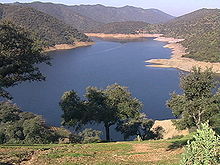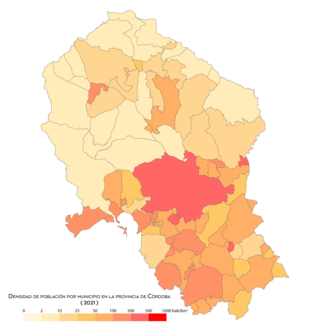Cordoba Province (Spain)
Córdoba is a province in southern Spain, in the north-central part of the autonomous community of Andalusia. It limits with the provinces of Seville, Badajoz, Málaga, Ciudad Real, Jaén, and Granada. Its capital is Cordoba. The government of the province is exercised by the Provincial Council of Córdoba.
Its area is 13,771 km². Its population is 781,451 inhabitants (2021). More than 40% live in the capital, and its demographic density is 56.74 inhab/km².
History
The Royal Decree of November 30, 1833 created the Province of Córdoba, which was formed by uniting the towns of the Kingdom of Córdoba and the following places in Extremadura: Belalcázar, Fuente la Lancha, Hinojosa del Duque and Villanueva del Duque. However, Chillón and its village of Guadalmez, places belonging to the kingdom, became part of the province of Ciudad Real. Likewise, the new province incorporated two enclaves of the Kingdom of Jaén that existed in the kingdom of Córdoba: Belmez (which included Peñarroya-Pueblonuevo, segregated in 1886) and Villafranca de Córdoba. Currently, the province is made up of the municipalities that can be seen in the annex Municipalities of the province of Córdoba.
Geography
The province is divided mainly into three geographical areas: Sierra Morena to the north, the Guadalquivir valley in the center and the Sierras Subbéticas to the south.
Climate
The climate is continental Mediterranean with temperatures that in the capital range between 9.2 °C in January and 27.2 °C in July and August, with highs that sometimes exceed 40 °C. The thermal amplitude is very frequent, especially in summer with a difference of 20 °C between day and night. Rainfall in the province varies between 400 to 600 mm a year, concentrating from October to April.
Pollution
According to Ecologistas en Acción, around a population of 330,000 people have breathed air with levels of polluting substances above the established limits. This would affect the inhabitants of the Córdoba capital area and the Puente Nuevo thermal power plant. The latter was cut off on June 30, 2020 in its commitment to renewable energy.
Protected natural areas
Natural parks
The province has three natural parks:
- Sierra de Cardeña and Montoro natural park with 38 449 hectares protected in the municipalities of Cardeña and Montoro
- Sierra de Hornachuelos with 60 032 hectares protected in the municipalities of Almodóvar del Río, Córdoba, Hornachuelos, Posadas and Villaviciosa de Córdoba
- Natural park of the Sierras Subbéticas with 32 056 hectares protected in the municipalities of Cabra, Carcabuey, Doña Mencia, Iznájar, Luque, Priego de Córdoba, Rute and Zuheros
Peri-urban parks
- Parque periurbano Fuente Agria in Villafranca de Córdoba
- Parque periurbano Fuente La Zarza in Hinojosa del Duque
- Parque periurbano La Sierrezuela in Posadas
- Parque periurbano Los Cabezos in Palma del Río
- Parque periurbano Los Villares en Córdoba
Places
- Malpasillo reservoir
- Cordobilla reservoir
- San Rafael de Navallana reservoir
- Sierra Boyera reservoir
- New Bridge reservoir
- Guadalmellato reservoir
- San Pedro reservoir
- Laguna de Tíscar
- Breña reservoir
- Hornachuelos reservoir
- Reservoir
- Iznájar reservoir
- Yeguas reservoir
- Guadanuño reservoir
- Embalse de la Encantada
- Martin Gonzalo reservoir
- Carpio reservoir
- Vadomojón reservoir
Natural monuments
- Sotos de la Albolafia
- Cave of the Bats
- Cave and Sima of the Angel
- The Sima of Cabra
Nature reserves
- Laguna Amarga
- Laguna de los Jarales
- Laguna de Tíscar
- Laguna de Zóñar
- Laguna del Conde o Salobral
- Laguna del Rincón
Population
Evolution
Distribution
| N.o | Municipality | Population | % of the province |
|---|---|---|---|
| 1 | Córdoba | 326 039 | 41.48 % |
| 2 | Lucena | 42 733 | 5.42 % |
| 3 | Genil Bridge | 30 241 | 3.8 % |
| 4 | Montilla | 23 031 | 2.93 % |
| 5 | Priego de Córdoba | 22 585 | 2.88 % |
| 6 | Palma del Río | 21 159 | 2.69 % |
| 7 | Cabra | 20 417 | 2.60 % |
| 8 | Babe | 19 338 | 2.46 % |
The province of Córdoba is the 11th in Spain in which there is a higher percentage of inhabitants concentrated in its capital (41.71%, compared to 31.96% for the whole of Spain). In 2012 the province reached its historical maximum population, with 802,719 inhabitants. Since then it has been declining considerably, losing over 20,000 residents in a decade. Among the causes is the aging of the population, a low birth rate and a gradual exile of young people in search of employment, to other areas of Spain or the EU. As of March 2020 with the Covid-19 pandemic, the province lost 990 inhabitants (until July 2021). As of January 1, 2021, 781,451 inhabitants were registered.
Immigration
Territorial organization
The province, made up of 77 municipalities, is made up administratively by 7 associations and judicially by 12 judicial districts.
Municipalities
The basic administrative unit into which the province is divided are the municipalities. There are 77 today. The municipality with the most inhabitants is the provincial capital. The province has an enclave within the province of Seville in which the town of Villar is located, belonging to the municipality of Fuente Palmera.
The municipalities of the province of Córdoba ordered by population are the following (according to the municipal register of the INE in 2020):
Commonwealths
Judicial parties
There are 12 judicial districts in the province:
| Judiciary Party | Municipalities comprising |
|---|---|
| Aguilar Judicial Party | Aguilar de la Frontera, Monturque and Moriles. |
| Baena Judicial Party | Baena, Luque and Valenzuela. |
| Cabra judicial party | Cabra, Doña Mencía, Nueva Carteya and Zuheros. |
| Judiciary Party of Córdoba | Castro del Río, Córdoba, Espejo, Obejo, Villaharta and Villaviciosa de Córdoba. |
| Justice Party of Lucena | Benamejí, Encinas Reales, Iznájar, Lucena, Palenciana and Rute. |
| Judiciary Party of Montilla | Fernán-Núñez, La Guijarrosa, Montalbán de Córdoba, Montemayor, Montilla, La Rambla, San Sebastián de los Ballesteros, La Victoria and Santaella. |
| Montoro Judicial Party | Adamuz, Bujalance, Cañete de las Torres, Cardeña, El Carpio, Montoro, Pedro Abad, Villa del Río and Villafranca de Córdoba. |
| Peñarroya-Pueblonuevo judicial party | Belalcázar, Belmez, Los Blázquez, Espiel, Fuente la Lancha, Fuente Obejuna, La Granjuela, Hinojosa del Duque, Peñarroya-Pueblonuevo, Valsequillo and Villanueva del Rey. |
| Posadas Judicial Party | Almodóvar del Río, La Carlota, Fuente Carreteros, Fuente Palmera, Guadalcázar, Hornachuelos, Palma del Río and Posadas. |
| Partido judicial de Pozoblanco | Alcaracejos, Añora, Conquista, Dos Torres, El Guijo, Pedroche, Pozoblanco, Santa Eufemia, Torrecampo, Villanueva de Córdoba, Villanueva del Duque, Villaralto and El Viso. |
| Judicial Party of Priego de Córdoba | Almedinilla, Carcabuey, Fuente-Tójar and Priego de Córdoba. |
| Genil Bridge Judiciary Party | Genil Bridge. |
Symbols
Shield
On a silver field a rampant lion gules (red or purple from the lion crown) since Córdoba was conquered by Fernando III with soldiers from the lion crown. Border composed of the royal arms of the crowns of León and Castilla. At the buzzer, royal crown closed. The mouth of the shield will be that of modern Spanish, that is to say: square and rounded at its base, with 6 units high (from the axis to the tip) for every 5 units wide (from the right flank to the sinister flank).
Flag
Rectangular cloth one and a half times as long, from the stem to the flap, as it is wide; purple color. Centered the shield of the province of Córdoba with its corresponding stamp, with the dimensions of the shield, from the crown of the stamp to the tip, ½ of the total width of the flag, and the rest of the proportions in accordance.
Logo
The logo is made up of a symbol that represents the synthesized figure of a rampant lion in yellow color (Pantone 117), which stands in front of a mass of red color (Pantone 485), which on its right side, due to its In this way, draw the initial of the word Córdoba, together with the legend Diputación de Córdoba with the Trade Gothic Bold 2 font for the word "Diputación" and Trade Gothic Light for "de Córdoba", both in black.
Education
Cordoba University
The University of Córdoba was founded as such in 1972, although it has two centuries of history that support a trajectory that has its roots in the Free University, which operated in the province at the end of the 19th century and has centuries-old studies such as those of the Faculty of Veterinary Medicine, unique in Andalusia.
Its youth and its average size -the UCO has 21,000 students, just over 1,200 professors and 700 workers- have given it the necessary dynamism to adapt and enter the century XXI as a university with high teaching quality and proven scientific solvency.
The studies at the University of Córdoba range from Humanities and Legal-Social Sciences to Health Sciences and scientific-technical careers, three areas that correspond to its structure in three large campuses: Social Law, integrated in the urban center; that of Health, to the west of the capital, and the Agrifood, Scientific and Technical of Rabanales, in the eastern area. In addition, the UCO has the Belmez Polytechnic School, located sixty kilometers from the Cordoba capital.
Contenido relacionado
Kingdom of Iberia
Watershed
Maracay
Machu Picchu base
Wadati-Benioff zone











